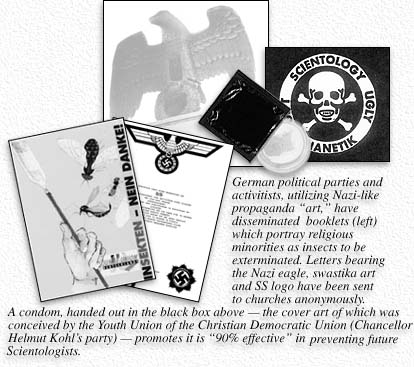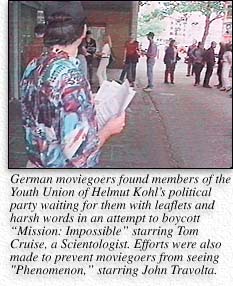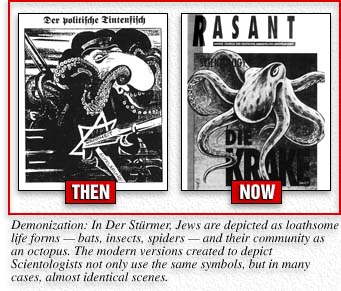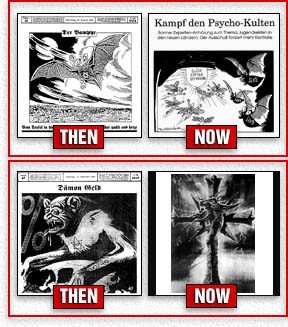


icket lines blocked sidewalks outside cinemas all over Germany. There was nothing unusual about that. After all, the movie was already one of Hollywood’s most successful films of 1996 and its German release had been long anticipated.
But a shadow hung over the crowds. Moviegoers found members of the youth union of Helmut Kohl’s political party waiting for them with leaflets and harsh words. “Do not see this film,” was the demand made by the somber young agents.

No, it had nothing to do with the film itself. Kohl’s political party—the Christian Democratic Union (CDU)—were not trying to protect citizens from the content of the show. They simply did not want it to be a success. Why? Religious intolerance—not even denied. They disagree with the personal religious beliefs of the film’s star and producer, so they set out to boycott it all over Germany.
What made this assault on Mission: Impossible all the more serious of course, is that this was Germany. Boycotting and banning art there have ugly precedents. In September 1933, the German government passed the Law Regarding Establishment of a Reich Chamber of Culture. This was the basis for excluding all non-Aryans from exhibiting art, performing music, creating literature—non-Aryan works literally being termed “degenerate art. ”
The uproar that followed the attacks on Cruise—a Scientologist—was made worse by incendiary remarks by CDU officials at the time, such as MP Johannes Gerster, who remarked that it was time to “step on the gas” in their intolerance campaign. This was too much even for many Germans, more than one of whom commented that if this was meant to be a pun on “gas,” only Joseph Goebbels would laugh.
The attacks on Mission: Impossible were a dismal failure. The film was a huge success with the German people largely ignoring the boycott. The politicians apparently decided that the mere presence of a Scientology actor wasn’t enough to expect the German people to stay away. The CDU was even more vitriolic over the release of Phenomenon, starring John Travolta. So, for Phenomenon they added a new twist. Not only was the star a Scientologist, but his religious beliefs were, they said, subliminally spread through the movie. The ludicrous “warnings” continued even after the screenwriter proclaimed the idea absurd since he wrote the story long before meeting Travolta or knowing anything about Scientology.
Following the Young Union’s boycott announcements, the U. S. Department of State again communicated its disapproval to the German government, but the reaction was far from limited to the United States.
The Dutch newspaper Volksrant reported that “Dutch politicians have reacted with aversion to the measurements taken in Germany against the Scientology movement.” Christian Democratic Appeal Party Member of Parliament Mr. Hillen said the German government had gone too far. “I’m not pleased at all with these actions in Germany,” he said.
Mr. M. de Bruyne, a spokesman for another Dutch political party, condemned the boycott as well as the Bavarian government’s announcement that it intended to augment the CDU’s campaign by implementing discriminatory employment policy. “Honestly, it frightened me. You need to have very strong arguments to exclude people from professions. This is very radical indeed,” he said.
The return of discrimination against artists in Germany because of their religious beliefs first came to international attention in 1993 when the government of the state of Baden-Wurttemburg cancelled a state-funded concert performance after finding out that jazz great Chick Corea is also a Scientologist.
Since then, Corea—whose music is enormously popular in Germany—has been prevented from performing at a number of concerts and has been the subject of repeated derogatory media reports.
German artists have also suffered. Painters have had exhibits shut down, and one was warned by galleries as far away as Finland and Moscow that they had been approached by German politicians to dissuade them from displaying his works because of his religion.
 Art of the Third Reich
Art of the Third Reich
In addition to boycotting works involving Scientology artists, German officials have also employed propaganda art to spread outrageous falsehoods—not only about Scientology, but about any other religion deemed “wrong.”
In a paper entitled “Art As Propaganda Against Jews and Scientologists: Echoes of the Past Renewed in Germany,” Dr. Stephen C. Feinstein, Jewish authority on European history and art, writes that current attacks in Germany on minority religions, including Scientology, are indisputably replays of the attacks on Jews in the 1930s.
Feinstein, chairman of the history department at the University of Wisconsin—River Falls, says that “many of the attacks and representations of Scientology bear more than a slight resemblance to the misuse of art during the Third Reich in the anti-Semitic campaigns against the Jews ”. His paper takes note of editorial cartoons from the Nazis’ Der Stürmer in the 1930s whose editor, Julius Streicher, was hanged after being found guilty in the trials at Nuremberg for his part in fanning the flames of hatred against Jews. Professor Feinstein then describes editorial cartoons from the 1990s that pillory Scientology—cartoons nearly identical to Der Stürmer’s anti-Semitic defamation of 60 years ago—and describes them thus:
“The extremely negative and anti-Semitic images of the Jew which appeared in Julius Streicher’s Der Stürmer are well-known. Certain themes which appeared in that Nazi newspaper and other manifestations of public propaganda art during the Third Reich are useful to cite, as they seem to have provided some sort of negative memory which has now been recalled and applied to the attack on Scientology. To be sure, many newspaper editorial cartoonists often walk a fine line between critique and offensiveness in their visual representations. . . . In contemporary Germany, the attack on Scientology has a crusade-like mentality associated with images intended to demonize and destroy, in a way not clearly delineated. . . . One need not seek a consistent logic or message in this attempt to demonize. None exists.”
The similarity between the cartoons then and now is so striking there can be no doubt that it is intentional. In Der Stürmer, Jews are depicted as loathsome life forms—bats, insects, spiders—and their community as an octopus. The modern versions created to depict Scientologists not only use the same symbols, but in many cases, almost identical scenes.
 Politicians Advocate Genocide
Politicians Advocate Genocide
However reprehensible the role of the media in spreading intolerance, none of the Nazi-like propaganda art currently distributed in Germany is as virulent and hate-filled as that produced by members of Chancellor Kohl’s Christian Democratic Union.
At a CDU convention in 1993, party Secretary General and Christian theologian Peter Hintze released a booklet called InSekten—Nein Danke, later distributed throughout Germany. The title was a play on the word “Sekten“—religious sects. The cover art portrays members of minority religions as insects to be crushed by a strong hand wielding a fly swatter. Stickers bearing the same image were available by mail order from party headquarters in Bonn.
The “art” inside the booklet included images such as a skull and crossbones surrounded by the words “Scientology,” “ugly” and “poison”. Those in the CDU responsible for this creation then took it one step further: The same skull and crossbones image was used as the cover art for boxes of condoms. The back cover says they are “90% effective” in “preventing” future Scientologists.
CDU officials today persist in their assertions that there is no evidence of religious intolerance in Germany. If their own propaganda literature is not enough to put the lie to such claims, even more blatant evidence can be found in other material which has been anonymously distributed. A letter sent to the Church of Scientology in Hamburg purported to be from the “Propaganda Ministry Berlin—SS State Protection Department”. Beneath the Nazi eagle and swastika its authors threaten they will be taking “sizeable measures” against the Church.
Still, Johannes Gerster and his party associates say there is no evidence of discrimination.
 Growing Concern
Growing Concern
Among many U. S. Congressmen who have criticized the ongoing discrimination is Representative Benjamin Gilman, chairman of the Congressional Committee on International Relations. In a letter requesting the intervention of the U. S. Secretary of State, Gilman said, “this intolerance seems to have crossed the line into discriminatory action prohibited by the Universal Declaration of Human Rights and the Helsinki Accord.”
Dr. Feinstein notes that “The last great group of alleged ‘demons’ that were perceived as a threat to German society, the Jews, wound up being exterminated, along with millions of their co-religionists in neighboring countries.”
Is the comparison justified?
Feinstein points out, “While many critics see such comparisons as either foolish or obscene, the issue nevertheless persists. The failure of many in Germany, including officials, to restrain unconstitutional acts against Scientology, has created a hate campaign with ominous overtones.”
Sadly, current events tend to support history—Germany is continuing to require outside monitoring to ensure that “never again” is more than political rhetoric.


